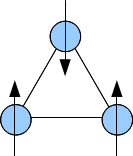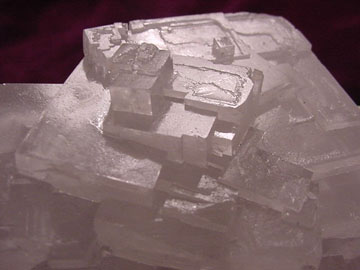|
Herbertsmithite
Herbertsmithite is a mineral with chemical structure Zn Cu3( OH)6 Cl2. It is named after the mineralogist Herbert Smith (1872–1953) and was first found in 1972 in Chile. It is polymorphous with kapellasite and closely related to paratacamite. Herbertsmithite is generally found in and around Anarak, Iran, hence its other name, anarakite. Herbertsmithite is associated with copper mineralizations in syenitic porphyries and granites in Chile and in Triassic dolomite formations in Iran. It has also been reported from the Osborn District in the Big Horn Mountains of Maricopa County, Arizona and the Lavrion District Mines of Attica, Greece. Herbertsmithite has a vitreous luster and is fairly transparent with a light-green to blue green color. Herbertsmithite has a Mohs hardness of between 3 and 3.5 and is known to have a brittle tenacity. The crystal's density has been calculated at 3.76 g/cm3. Herbertsmithite, in a pure synthetic form, was discovered in 2012 to be able to exhib ... [...More Info...] [...Related Items...] OR: [Wikipedia] [Google] [Baidu] |
Quantum Spin Liquid
In condensed matter physics, a quantum spin liquid is a phase of matter that can be formed by interacting quantum spins in certain magnetic materials. Quantum spin liquids (QSL) are generally characterized by their long-range quantum entanglement, fractionalized excitations, and absence of ordinary magnetic order. The quantum spin liquid state was first proposed by physicist Phil Anderson in 1973 as the ground state for a system of spins on a triangular lattice that interact antiferromagnetically with their nearest neighbors, i.e. neighboring spins seek to be aligned in opposite directions. Quantum spin liquids generated further interest when in 1987 Anderson proposed a theory that described high temperature superconductivity in terms of a disordered spin-liquid state. Basic properties The simplest kind of magnetic phase is a paramagnet, where each individual spin behaves independently of the rest, just like atoms in an ideal gas. This highly disordered phase is the gen ... [...More Info...] [...Related Items...] OR: [Wikipedia] [Google] [Baidu] |
Herbert Smith (mineralogist)
Dr. George Frederick Herbert Smith (1872–1953), was a British mineralogist who worked for the British Museum of Natural History. He discovered the mineral paratacamite in 1906. He also developed the first efficient jeweller's refractometer. The mineral Herbertsmithite is named after him, as is Herbert's rock-wallaby. Referenceswebmineral.comHas information on Herbertsmithite and brief biographical details. Accessed March 2007Archives of Herbert Smith's career 1897–1937at the Natural History Museum External links * Works bHerbert Smithat Project Gutenberg Project Gutenberg (PG) is a volunteer effort to digitize and archive cultural works, as well as to "encourage the creation and distribution of eBooks." It was founded in 1971 by American writer Michael S. Hart and is the oldest digital li ... 1872 births 1953 deaths British mineralogists Employees of the British Museum {{UK-scientist-stub ... [...More Info...] [...Related Items...] OR: [Wikipedia] [Google] [Baidu] |
Halide Mineral
Halide minerals are those minerals with a dominant halide anion (, , and ). Complex halide minerals may also have polyatomic anions. Examples include the following: * Atacamite *Avogadrite (K,Cs)BF *Bararite (β) *Bischofite * Brüggenite * Calomel * Carnallite * Carnallite *Cerargyrite/ Horn silver AgCl * Chlorargyrite AgCl, bromargyrite AgBr, and iodargyrite AgI * Cryolite * Cryptohalite (a) . * Dietzeite * Eglestonite * Embolite AgCl+AgBr * [...More Info...] [...Related Items...] OR: [Wikipedia] [Google] [Baidu] |
Triassic
The Triassic ( ) is a geologic period and system which spans 50.6 million years from the end of the Permian Period 251.902 million years ago (Mya), to the beginning of the Jurassic Period 201.36 Mya. The Triassic is the first and shortest period of the Mesozoic Era. Both the start and end of the period are marked by major extinction events. The Triassic Period is subdivided into three epochs: Early Triassic, Middle Triassic and Late Triassic. The Triassic began in the wake of the Permian–Triassic extinction event, which left the Earth's biosphere impoverished; it was well into the middle of the Triassic before life recovered its former diversity. Three categories of organisms can be distinguished in the Triassic record: survivors from the extinction event, new groups that flourished briefly, and other new groups that went on to dominate the Mesozoic Era. Reptiles, especially archosaurs, were the chief terrestrial vertebrates during this time. A specialized subgroup of arch ... [...More Info...] [...Related Items...] OR: [Wikipedia] [Google] [Baidu] |
Condensed Matter (journal)
This is a list of academic journals published by MDPI. As of September 2022, MDPI publishes 399 peer-reviewed academic journals and nine conference journals. {, class="wikitable sortable" , +List of MDPI journals !Journal name !Subject !Established !Impact factor !Scopus ranking (2021) !ISSN , - , ''Acoustics'' , Engineering , 2019 , Impact factors are calculated on the previous two years. Impact factors for journals established in 2019 will not be available until 2022. , – , 2624-599X , - , ''Actuators'' , Engineering , 2012 , 2.062nd percentile, 2076-0825 , - , ''Administrative Sciences'' , Business , 2011 , 69th percentile, 2076-3387 , - , ''Adolescents'' , Health , 2021 , Impact factors are calculated on the previous two years. Impact factors for journals established in 2021 will not be available until 2024. , – , 2673-7051 , - , ''Advances in Respiratory Medicine'' (formerly ''Pneumonologia i Alergologia Polska)'' , Health , , 27th percentile, 2451-4934 , - , ... [...More Info...] [...Related Items...] OR: [Wikipedia] [Google] [Baidu] |
Ferromagnetism
Ferromagnetism is a property of certain materials (such as iron) which results in a large observed magnetic permeability, and in many cases a large magnetic coercivity allowing the material to form a permanent magnet. Ferromagnetic materials are the familiar metals noticeably attracted to a magnet, a consequence of their large magnetic permeability. Magnetic permeability describes the induced magnetization of a material due to the presence of an ''external'' magnetic field, and it is this temporarily induced magnetization inside a steel plate, for instance, which accounts for its attraction to the permanent magnet. Whether or not that steel plate acquires a permanent magnetization itself, depends not only on the strength of the applied field, but on the so-called coercivity of that material, which varies greatly among ferromagnetic materials. In physics, several different types of material magnetism are distinguished. Ferromagnetism (along with the similar effect ferrimagnetism ... [...More Info...] [...Related Items...] OR: [Wikipedia] [Google] [Baidu] |
Magnetism
Magnetism is the class of physical attributes that are mediated by a magnetic field, which refers to the capacity to induce attractive and repulsive phenomena in other entities. Electric currents and the magnetic moments of elementary particles give rise to a magnetic field, which acts on other currents and magnetic moments. Magnetism is one aspect of the combined phenomena of electromagnetism. The most familiar effects occur in ferromagnetic materials, which are strongly attracted by magnetic fields and can be magnetized to become permanent magnets, producing magnetic fields themselves. Demagnetizing a magnet is also possible. Only a few substances are ferromagnetic; the most common ones are iron, cobalt, and nickel and their alloys. The rare-earth metals neodymium and samarium are less common examples. The prefix ' refers to iron because permanent magnetism was first observed in lodestone, a form of natural iron ore called magnetite, Fe3O4. All substances exhibit some ... [...More Info...] [...Related Items...] OR: [Wikipedia] [Google] [Baidu] |
Kagome Lattice
In geometry, the trihexagonal tiling is one of 11 uniform tilings of the Euclidean plane by regular polygons. See in particular Theorem 2.1.3, p. 59 (classification of uniform tilings); Figure 2.1.5, p.63 (illustration of this tiling), Theorem 2.9.1, p. 103 (classification of colored tilings), Figure 2.9.2, p. 105 (illustration of colored tilings), Figure 2.5.3(d), p. 83 (topologically equivalent star tiling), and Exercise 4.1.3, p. 171 (topological equivalence of trihexagonal and two-triangle tilings). It consists of equilateral triangles and regular hexagons, arranged so that each hexagon is surrounded by triangles and vice versa. The name derives from the fact that it combines a regular hexagonal tiling and a regular triangular tiling. Two hexagons and two triangles alternate around each vertex, and its edges form an infinite arrangement of lines. Its dual is the rhombille tiling. This pattern, and its place in the classification of uniform tilings, was already known to Johan ... [...More Info...] [...Related Items...] OR: [Wikipedia] [Google] [Baidu] |
EPL (journal)
''EPL'' is a peer-reviewed scientific journal published by EDP Sciences, IOP Publishing and the Italian Physical Society on behalf of the European Physical Society and 17 other European physical societies. Prior to 1 January 2007 it was known as ''Europhysics Letters''. Scope ''EPL'' publishes original letters that communicates new results and findings that merit rapid publication in all areas of physics. ''EPL'' also publishes comments on letters previously published in the journal. History ''Europhysics Letters'' was founded in 1986 by the European Physical Society (EPS), Société Française de Physique (SFP) and its subsidiary EDP Sciences, the Società Italiana di Fisica (SIF) and the Institute of Physics (IOP). The new journal incorporated '' Lettere al Nuovo Cimento'' and '' Journal de Physique: Lettres'' and was published by EPS, EDP Sciences and SIF until 2006. ''EPL'' is now published under the scientific policy and control of the EPS by EDP Sciences, IOP Publishi ... [...More Info...] [...Related Items...] OR: [Wikipedia] [Google] [Baidu] |
Mohs Hardness
The Mohs scale of mineral hardness () is a qualitative ordinal scale, from 1 to 10, characterizing scratch resistance of various minerals through the ability of harder material to scratch softer material. The scale was introduced in 1812 by the German geologist and mineralogist Friedrich Mohs, in his book ''"Versuch einer Elementar-Methode zur naturhistorischen Bestimmung und Erkennung der Fossilien"''; it is one of several definitions of hardness in materials science, some of which are more quantitative. The method of comparing hardness by observing which minerals can scratch others is of great antiquity, having been mentioned by Theophrastus in his treatise ''On Stones'', , followed by Pliny the Elder in his '' Naturalis Historia'', . The Mohs scale is useful for identification of minerals in the field, but is not an accurate predictor of how well materials endure in an industrial setting – ''toughness''. Minerals The Mohs scale of mineral hardness is based on the abilit ... [...More Info...] [...Related Items...] OR: [Wikipedia] [Google] [Baidu] |
Lustre (mineralogy)
Lustre (British English) or luster (American English; see spelling differences) is the way light interacts with the surface of a crystal, rock, or mineral. The word traces its origins back to the Latin ''lux'', meaning "light", and generally implies radiance, gloss, or brilliance. A range of terms are used to describe lustre, such as ''earthy'', ''metallic'', ''greasy'', and ''silky''. Similarly, the term ''vitreous'' (derived from the Latin for glass, ''vitrum'') refers to a glassy lustre. A list of these terms is given below. Lustre varies over a wide continuum, and so there are no rigid boundaries between the different types of lustre. (For this reason, different sources can often describe the same mineral differently. This ambiguity is further complicated by lustre's ability to vary widely within a particular mineral species). The terms are frequently combined to describe intermediate types of lustre (for example, a "vitreous greasy" lustre). Some minerals exhibit unu ... [...More Info...] [...Related Items...] OR: [Wikipedia] [Google] [Baidu] |







